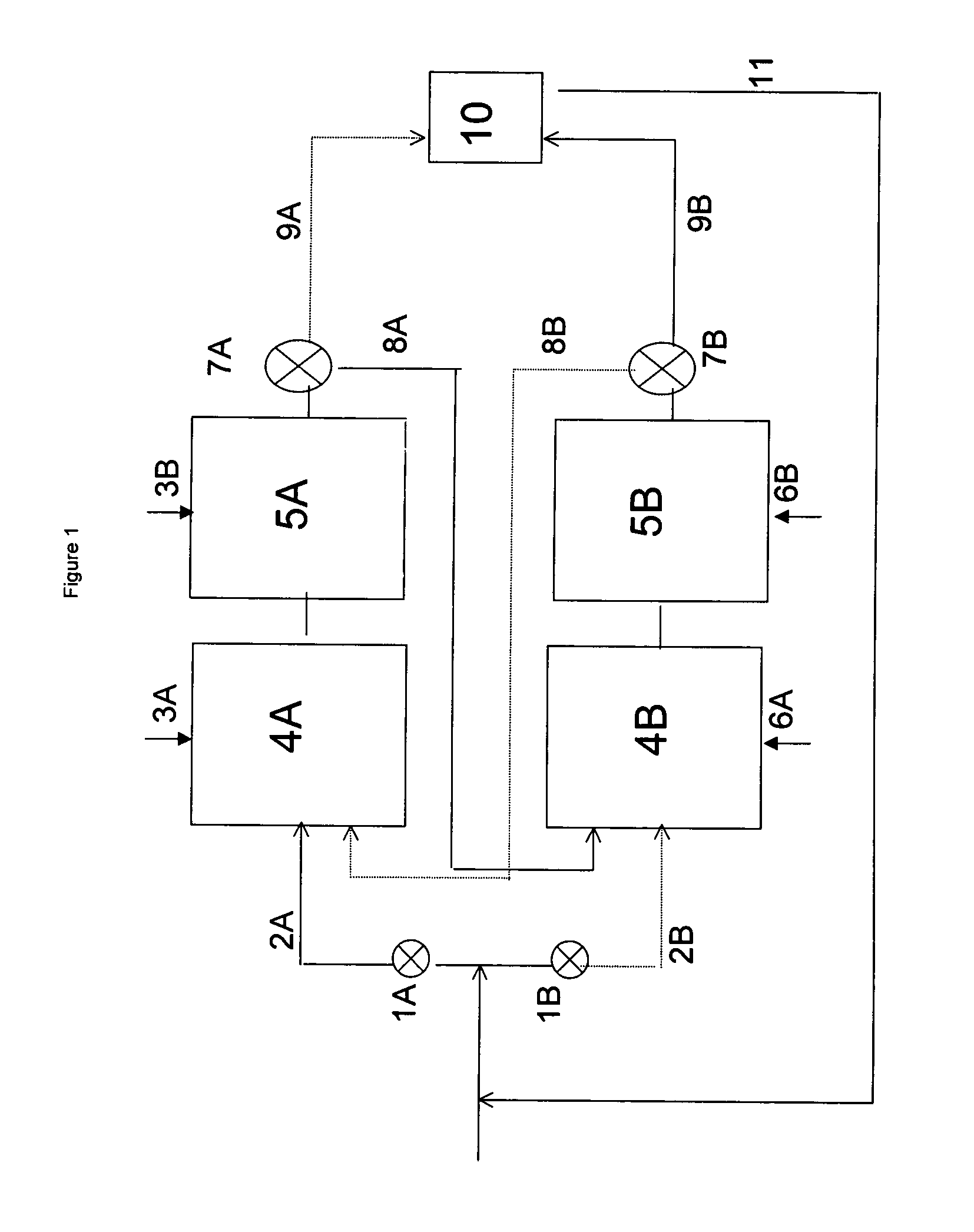Continuous process for the alkylation of hydrocarbons
a technology of hydrocarbons and alkylation process, which is applied in the direction of hydrocarbon preparation catalysts, organic chemistry, chemistry apparatus and processes, etc., can solve the problems of reactor flushing, valve and tubing clogging, and reactors need to be introduced in separate apparatuses
- Summary
- Abstract
- Description
- Claims
- Application Information
AI Technical Summary
Problems solved by technology
Method used
Image
Examples
first embodiment
[0027]In the present invention, at least a portion of the alkylation mode alkylate-containing effluent is led via valve system 7A and through duct 8A to zone B, which contains reactors 4B and 5B, which reactors are in the regeneration mode. If only a portion of the alkylation mode alkylate-containing effluent is led to zone B, the remaining portion of the alkylation mode alkylate-containing effluent can be led through duct 9A to separation unit 10. If desired, alkylatable compound may be added to the portion of the alkylation mode alkylate-containing effluent which is led to zone B. In this embodiment it is preferred, however, to lead the entire alkylation mode alkylate-containing effluent to zone B.
[0028]Hydrogen is fed to reactor 4B or to both reactor 4B and reactor 5B through inlet 6A and inlets 6A and 6B, respectively. The alkylation mode alkylate-containing effluent which is led to zone B is first introduced into reactor 4B. Subsequently, the effluent of reactor 4B, which is a ...
second embodiment
[0031]In a second embodiment, the entire alkylation mode alkylate-containing effluent is led through duct 9A to separation unit 10. At the same time, alkylatable compound is introduced via duct 2B into reactor 4B, which is in the regeneration mode. The effluent of this reactor is subsequently led to reactor 5B. The effluent of reactor 5B, i.e. the regeneration mode effluent, is then led via valve system 7B and through duct 9B to separation unit 10. The reactors in zone A and zone B can be cycled between the alkylation mode and the regeneration mode by switching the streams coming through inlets 3A / B and 6A / B. By switching the streams coming through inlets 3A / B and 6A / B hydrogen is fed to reactor 4A or to reactors 4A and 5A both and the alkylation agent is fed to reactors 4B and 5B.
third embodiment
[0032]In a third embodiment, no streams are introduced into reactor 4B via ducts 2B or 8A while reactors 4B and 5B are operating in the regeneration mode, and the entire alkylation mode alkylate-containing effluent is led through duct 9A to separation unit 10. Alkylate, formed during the time when reactors 4B and 5B operated in the alkylation mode, is still present in these reactors. In principle, reactors 4B and 5B will be isolated from the system, meaning that no streams leave the reactor via valve system 7B during the regeneration period. However, it may be necessary to relieve the pressure from the reactor, e.g. via duct 9B.
[0033]The reactors in zone A and zone B can be cycled between the alkylation mode and the regeneration mode by, e.g., (i) switching the streams coming through inlets 3A / B and 6A / B and (ii) changing the streams through ducts 2A and 2B. In this mode, hydrogen is fed to reactor 4A or to reactors 4A and 5A both and the alkylation agent is fed to reactors 4B and 5...
PUM
| Property | Measurement | Unit |
|---|---|---|
| temperature | aaaaa | aaaaa |
| temperature | aaaaa | aaaaa |
| pressure | aaaaa | aaaaa |
Abstract
Description
Claims
Application Information
 Login to View More
Login to View More - R&D
- Intellectual Property
- Life Sciences
- Materials
- Tech Scout
- Unparalleled Data Quality
- Higher Quality Content
- 60% Fewer Hallucinations
Browse by: Latest US Patents, China's latest patents, Technical Efficacy Thesaurus, Application Domain, Technology Topic, Popular Technical Reports.
© 2025 PatSnap. All rights reserved.Legal|Privacy policy|Modern Slavery Act Transparency Statement|Sitemap|About US| Contact US: help@patsnap.com


